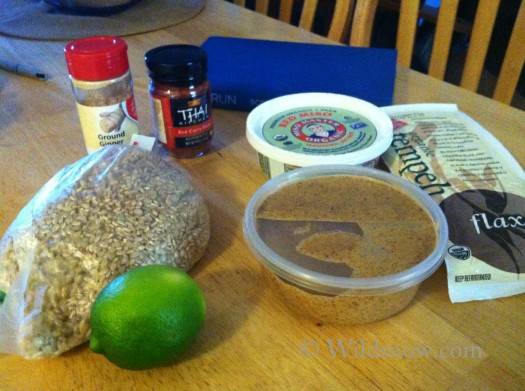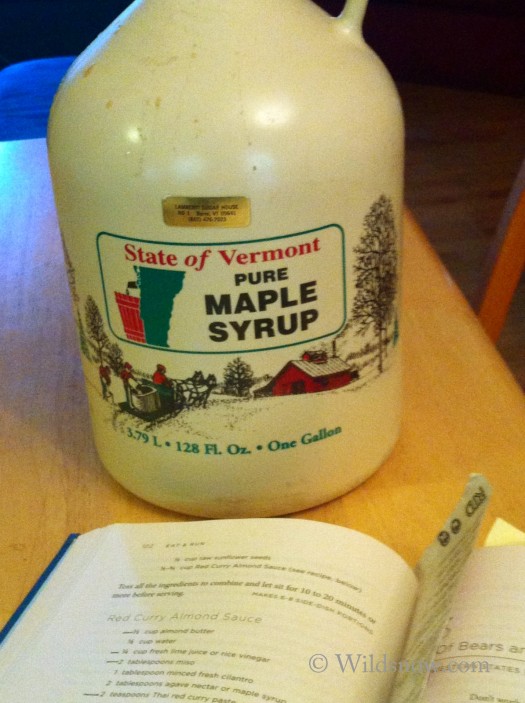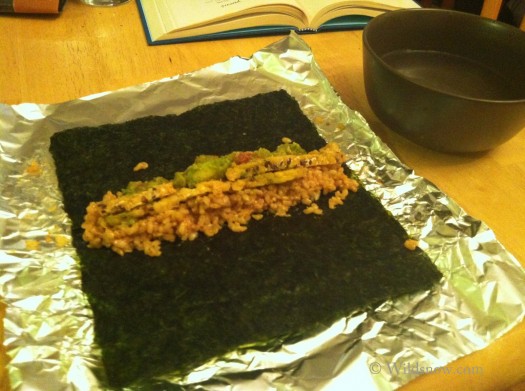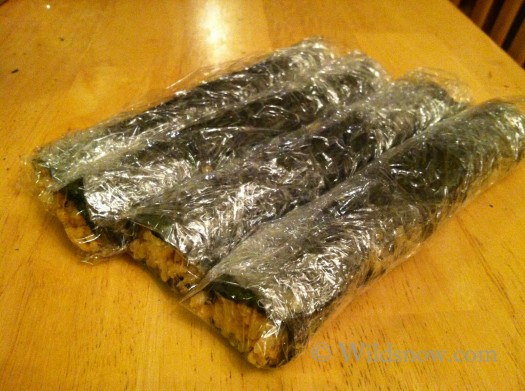We all need to eat. While this blog is called “Wildsnow,” not “Wildtrailrunning,” food is a great leveler. We can all draw lessons from conversations about what foods work for backcountry athletes, no matter our medium for pain and enjoyment.
Local Boulder ultrarunning legend, Scott Jurek, recently released a book sharing the secrets and struggles he learned from running hundreds of miles on a whole-food, plant-based diet. The book, “Eat and Run”: My Unlikely Journey to Ultramarathon Greatness, was released on June 5 and recently hit #7 on the New York Times’ Best Seller list for nonfiction. Jurek has won the Western States 100 Mile Endurance Run seven times, winning the Badwater Ultramarathon—a 135-mile race in Death Valley—shortly after his seventh Western States victory. Even if those credentials don’t make you pause and listen, whatever it is he’s doing seems to be working.

Yours truly and the man himself—Scott Jurek gathered with the Boulder-area running community on June 14 for a quick run, some good food, and a session of questions and jokes.
Jurek’s book talks a lot about pain and transcendence—mind over body. He seems to have found, and become addicted to, a part of his will that he finds after a certain number of miles and amount of struggle. We can all relate, no matter our sport or whether we happen to be ultramarathoners. The point when your will takes over—even from fatigued muscles and a pesky doubting mind—is a threshold you can find on a bike, a trail, or a pair of skis. It’s the moment when you recognize your fear (or your exhaustion, or your blisters, etc. etc.) and you keep moving anyway.

Brooks busted out the sample shoes at Boulder Running Company and let us take the Cascadia—a go-to trail shoe Jurek helped develop—for a spin.
Jurek’s book is about more than pain, it is also about food. His message, after all, is simple: eat to fuel your body. While he advocates a no-meat, no-dairy approach, the message is one of being conscientious of what your body needs and your responsibility for whatever you choose to put into it. Now on the road for his book tour, I met up with Jurek and a crew of Colorado’s fittest at Boulder Running Company for a quick jaunt, some yummy vegan food (thanks to Native Foods Café), and bit of conversation. Some, but certainly not all, of the take-aways from Jurek’s book and my evening with rockstar Colorado ultrarunners include:
· Essential fatty acids are important. Among the many glowing qualities of the omega fatty acids, omega 3 and 6 aid in recovery and reduce inflammation—important qualities for any athlete. The tricky part is that the body can’t produce them on its own.
· Steer clear of processed carbohydrates and refined sugars. Jurek explains that he still consumes these (gels, blocks, etc.) on long training days but he also packs potatoes, rice balls, and homemade hummus wraps.
· Make it work for you. Jurek reportedly often spends hours preparing his veggie meals, but Buzz Burrell, another Boulder trail running legend, assured us that he spends 15 minutes or less preparing food.
I’ve been doing the whole-food, plant-based, active lifestyle for about a month now. While I feel great, one of my issues is being hungry for a large portion of the day. In pursuit of something delicious and filling, I opted for a variation on two recipes in Jurek’s book in a form I’ve been wanting to try for a while: a nori roll. Jurek notes that he often takes burritos and rice balls on long runs and I ate a crunchy-store-bought nori roll at the high point of my last long trail run, so what could be better than recreating the nori burrito? Great fuel for any adventure.
Nori Roll with Red Curry Almond Sauce
(red curry almond sauce recipe courtesy of Eat and Run)
Red Curry Almond Sauce
¼ cup almond butter
½ cup water
¼ cup fresh lime juice or rice vinegar
2 tablespoons miso
1 tablespoon minced fresh cilantro
2 tablespoons agave nectar or maple syrup
2 tablespoons Thai red curry paste, or to taste
1 teaspoon onion powder
½ teaspoon garlic powder
½ teaspoon ground ginger
Nori Roll
1 cup brown rice
2 cups water
¼ package sliced tempeh
1 package nori
Optional: avocado, cucumber, red peppers, carrots (or anything else you feel like wrapping with nori and delicious rice)
Mix all ingredients for the red curry almond sauce in a bowl and set aside. Place rice and water in a sauce pan and bring to a boil (I rinse my rice before cooking to remove excess starch). Reduce to simmer for 40-50 minutes or until rice is cooked. While the rice is cooking, sauté tempeh with olive oil and salt and pepper to taste until lightly browned. When the rice is done, mix it with half of your red curry almond sauce and let cool enough to handle (save the rest of the sauce for the delicious rice noodles you’ll make later in the week or for your next batch of nori).
To make the rolls, place the nori rough-side down on a piece of tin foil (or a bamboo sushi roller if you have one). Keep a bowl of water nearby and make sure that you wet your hands to work with the rice but dry them off when you handle the nori. Grab a handful of rice and roll it into a ball before molding it into a long mound on the nori. Add a few strips of tempeh and any optional ingredients. Fold the nori over the mound and slowly work the nori into a roll using the tin foil (don’t worry, the nori is pretty forgiving for your first few attempts—you’re just trying to get the nori to stick to itself in some sort of roll). Now you’ve got yourself some travel-ready snacks that pack a good amount of protein, carbs, and veggies.
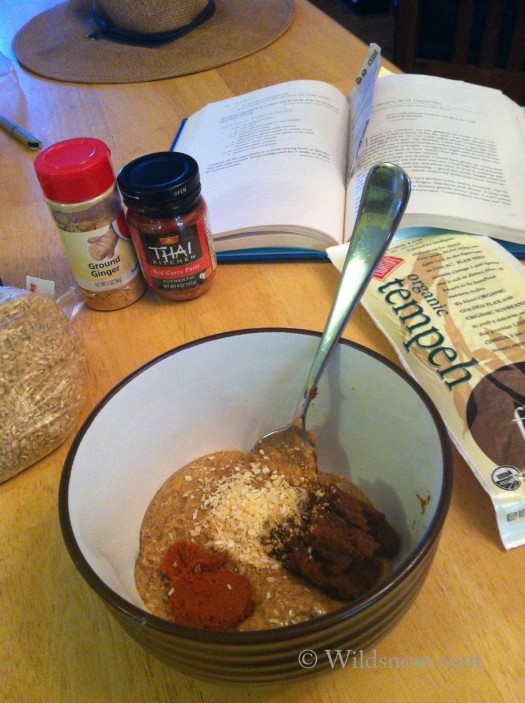
While studies on miso have mixed results, it’s considered a valuable tool in the plant-based diet arsenal. Derived from fermented soy, it packs a good protein punch and is a source of B-12 --my miso container even told me that it lowers the risk of breast cancer according to a recent University of Alabama study.
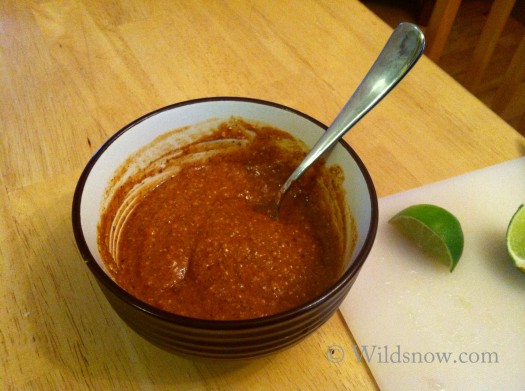
Once you gather all the ingredients, the sauce is beyond simple to make—combine the ingredients and stir. I omitted the cilantro and went easy on the Thai curry paste. To kick up the heat, add more curry paste and a bit of chili powder. The almond butter is delicious and almonds are a good source of protein and vitamin E.
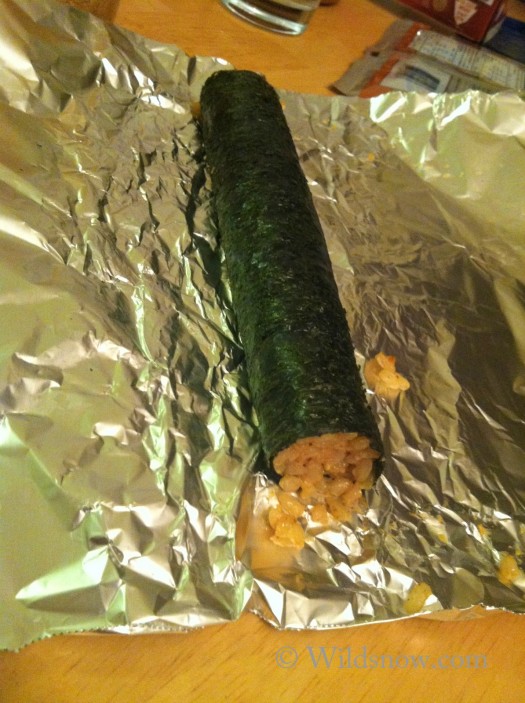
No sushi-rolling experience needed to make nori rolls. Tin foil and just a touch of patience is all you need.
(WildSnow.com guest blogger Jess Portmess currently lives in Boulder, Colorado. Having grown up in New York and Vermont, she’s now chasing snow covered peaks, endless trails, and a legal career in the West.)
Jess Portmess currently lives in Boulder, Colorado. Having grown up in New York and Vermont, she’s now chasing snow covered peaks, endless trails, and a legal career in the West

